 |
 |
 |
 |
 |
 |
 |
 |
Listen to this Programme on Radio Sai
PArt 1
Every festival in Prasanthi Nilayam is extraordinary but Shivarathri each year has been a spectacle! Especially the occasions when Bhagawan performed the divine act of Lingodbhavam – the emergence of the linga (a symbol of the cosmos) from His mouth! Thousands thronged to Puttaparthi to witness this glorious manifestation of Divine love. They spent the holy night ruminating on His form and His glories. It is time now again to relive those moments, understand their significance and learn how to remain in that state of Pure Love that Baba is, every moment of our lives.Here is an attempt to offer you some perspectives about this unique phenomenon that we have been blessed to witness in our lives – the Sri Sathya Sai Avatar. This is presented in the form of a dialogue which liberally draws from precious teachings from several enlightened souls who have graced this planet in the recent times. We hope this offers you insights into some of Baba's profound messages; every act of the Divine is so deeply significant and what Baba did during Shivarathri every year was no exception.
Sai Revitalises Someswara!
Prem: Sairam Bishu! How are you? So how was your trip to West India?
Bishu: It was fantastic Prem. By Baba's grace, I was at Somnath – one of the very powerful shrines dedicated to Lord Shiva.
Prem: Yes, it is one of the 12 jyothirlingas, right?
Bishu: Absolutely,
in fact the foremost in the list. And the most unique thing about this
shrine is Baba Himself was here way back in the seventies. In fact it is Baba, Shiva-Shakthi come as Sathya Sai, who recharged this shrine so to say by performing an out-of-the-world abhishekam of this shrine. I
have read about it. Baba reached Somnath on June 17, 1970 and He was
accompanied by the Rajamata (Queen Mother) of Nawanagar who was a great
devotee of Swami.
 |
 |
 |
 |
 |
 |
 |
 |
| The Someshwar shrine in Somnath in the state of Gujarat, India - one of the powerful shrines dedicated to Lord Shiva. | |||||||
Prem: Yes,
I have seen photos of her with Swami in our Radio Sai archives. In fact
she is the one who offered her land in Bangalore to Swami to construct
the Sathya Sai Hostel and College in Brindavan, Whitefield.
Bishu: Right.
Her husband, the late Jamsaheb was also an ardent devotee of Swami and a
great believer of God. In fact he is one of the persons primarily
responsible for the renovation of this historic shrine. Not many people
know that centuries ago the Somnath shrine actually was one of the
richest temples of India.
For this reason
unfortunately it was targeted and plundered by many rulers and
conquerors. Depredation, desecration, destruction, reconstruction and
rededication became recurring chapters of its long history. When the
temple was built for the fifth time the rulers of Delhi at the time
destroyed it again.
 |
 |
 |
 |
 |
 |
 |
 |
| The Rajamata of Nawanagar garlanding Bhagawan during one the Birthday celebrations in the yester years | |||||||
Finally after India
attained independence in 1947, Sardar Vallabhbhai Patel, the great
freedom fighter declared “We have decided that Somnath should be
reconstructed. This is a holy task in which all should participate.” And
one person who did participate wholeheartedly was the late Jamsaheb of
Nawanagar and so deep was his affection for this shrine that he built an
imposing achitectural gem at the entrance of this temple. Jamsaheb's
name was Dig Vijaya Singh and so this striking structure was named as
Dig Vijaya Dwar, meaning 'The Gateway of Victory'.
Prem: That sounds great!
Bishu: Yes,
and the most important thing is Baba inaugurated this hallowed
structure at the request of the Rajamata. In fact even before reaching
the shrine Baba had declared that He would reveal to all that day the
genuine Somnath! So all roads converging from Jamnagar to Somnath that
day were shouting jaikars in exhilaration.
Baba was ceremonially
received at the Dig Vijaya Dwar by the Trustees of the Somnath Temple
and amidst strains of temple music, He walked on the red carpet laid on
the steps and opened the lock on the artistically carved and
silver-embossed door with a silver key. The Rajamata was ecstatic.
 |
 |
 |
 |
 |
 |
 |
 |
| The 'Dig Vijay Dwar' built by the late Jamsaheb at the Someshwara shrine - it was inaugurated by Baba in June 1970. | |||||||
Prem: Thats wonderful. The royal couple loved Swami so much and here was a lovely blessing from the Lord.
Bishu: Not
only this, there are many more fascinating things that Swami did during
that historic visit. Once He entered the sanctum sanctorum of that holy
shrine which has been the focal point of the faiths of millions for
millennia, Swami directed that a plate be brought. And then He lovingly
spread the fingers of His right hand and shook it over the plate. You
know what happened?
108 silver Bilva leaves (Aegle marmelos is
the botanical name of the sacred plant Bilva or Stone Apple) and 108
golden flowers fell from His hand in a clinking shower. The fortunate
devotees standing nearby were stunned. They then reverentially touched
these mysterious manifestations. And after this Baba poured these leaves
of silver and flowers of gold on the 3 feet high lingam. Thus revitalising this holiest of shrines.
Prem: Wow!
 |
 |
 |
 |
 |
 |
 |
 |
| Bhagawan recharged this most sacred shrine in Somnath by performing a heavenly abhishekam of this linga | |||||||
Bishu: But this was not all. The next minute Baba's hand circled in the air and what a sight it was! A
ball of brilliant light was now sitting on His palm. Prof. Kasturi who
was a witness to this glorious event immediately recalled the
declaration that Baba had made earlier in the day: “I shall show you the
genuine Someswara lingam today!”
So that was it, the genuine Someswara lingam which according to the puranas “is a swayam-bhu or a self-originated lingam
of great prowess, as bright as the Sun, the size of an egg of a hen
which is situated underground.” For centuries this Ball of Light had
gone underground safe from depredation and desecration. Baba
now gave this to the chief priest and said, “Let it be in the full
light of the day hereafter! Let pious eyes admire its brilliance and
imprint its glory on their hearts. There is no need any more to keep it
away. The Avatar has come to remove all fear.”
Prem: What a triumphant emergence of Someswara! You are lucky to have visited this holy shrine!
 |
 |
 |
 |
 |
 |
 |
 |
| The grand Somnath shrine in Gujarat - a temple which was destroyed several times in history was finally rebuilt after India attained independence in 1947 | |||||||
Lingodbhavam – A Stirring Spectacle
Bishu: Prem, we are all lucky for we have seen Someswara Himself not just the lingam. Do you recall what a breathtaking sight it used to be in Prasanthi Nilayam whenever Bhagawan chose to perform lingodbhavam (emergence of the linga from His mouth)!
Prem:
Right Bishu. How glorious were those moments! I was fortunate to
witness this supremely auspicious event a couple of times or more, from
2000 to 2004. But while I was happy to see this amazing divine
spectacle, I was sad too. Really speaking it was difficult for me to
watch Swami go through all the pain that He was undergoing. I mean why
does He have to suffer so much? To just reward us with a thrilling
experience?
 |
 |
 |
 |
 |
 |
 |
 |
| The Creator and a replica of His cosmos! | |||||||
Bishu: Well
Prem, Swami once mentioned that He performed these out-of-the-world
miracles to help instill faith in the minds of the people so that they
learn to love god and fear sin.
Prem: But
so much suffering! Just for our sake! So that we believe in Him! Tell
me, do we need Swami to go through so much pain so that we begin to love
Him? Actually from the time Swami incarnated all He did was give, give
and give.... He just gave Himself away completely.
Bishu:
So true Prem. As a child He gave away His food to the beggar at the
door, His clothes to His siblings, His books to His classmates.... and
you remember the Kadiri horror story?
Prem: O
my god! Don’t remind me of that! I wish that chapter never existed in
Swami's life. I mean, how can someone tonsure Baba's head, make deep
cuts with a knife and then pour acidic juices into them!
Bishu: Yes,
but let's look at it in another way. What was Swami's reaction to all
this? He just smiled it away. He suffered because His parents took him
there and they would not be convinced when He told them that nobody has
possessed Him. He allowed Himself to be tortured so that His near and dear ones realise His true nature.
Prem:
And this is not the only incident. You take a leaf out of any chapter
of Swami's life and you can see how He has stretched Himself thin to
limits so that others are happy, so that others lead a more fulfilled
life.
Bishu: You
are so true Prem. You remember how in the last four years Swami used to
sit for such long hours in the Sai Kulwant Hall watching the programs.
Some days the sessions went on till 9 in the night. Everybody was tired
but not Swami! And He did this continuously day after day.
 |
 |
 |
 |
 |
 |
 |
 |
| During the last few years of His earthly sojourn Swami spent long hours in Sai Kulwant Hall blessing every group that came for His darshan | |||||||
In fact many days when
there was no program, He used to even ask the warden of the hostel, “No
program today?” Every group that came to Prasanthi Nilayam returned
immensely blessed by Him; He just gave Himself away.
Sai – Sacrifice in a Human Frame
I remember one particular
evening during the Dasara celebrations in 2009, that day Swami came and
after He was on the stage He listened to the vedam chants for an hour,
and then went round the devotees twice, and after this He returned to
the dais. Now bhajans began and Swami took arathi after a while. But as He was returning He saw Mr. Narasimha Murthy and said, “Go and speak! I am coming!”
And just as He had said, He was soon on the stage! The warden then went up to Him and said, “Swami, this will be shrama
for You (meaning, it will be difficult for You) as You already had a
long day.” As it was Dasara season, Swami used to sit for long hours in
the morning in the Poorna Chandra Auditorium watching the yagna. The warden was concerned about Swami's rest. But you know what Swami said? “Idi shrama kadu, Bangaru, Prema” meaning, “This is no exertion, golden one, this is Love.”
Bhagawan Ramana - The Sterling Saint of Arunachala
Prem: That
is Swami! He will do anything for the sake of His devotees, for the
sake of Love. In fact that is how it has been whenever God or godly
beings have incarnated on this earth.
 |
 |
 |
 |
|
| Bhagawan Sri Ramana Maharishi | ||||
Take for instance Sri
Ramana Maharishi of Thiruvannamalai, who attained mahasamadhi in 1950.
About two years before this, an innocuous looking lump appeared in his
left arm. This was promptly removed surgically, by the local doctor.
But when it reappeared after several such attempts, the devotees realised that it was a cancerous growth; it was actually a case of osteosarcoma, an extremely painful form of bone cancer.
But when it reappeared after several such attempts, the devotees realised that it was a cancerous growth; it was actually a case of osteosarcoma, an extremely painful form of bone cancer.
Bishu: It must’ve indeed been very difficult for those around him to see their beloved Guru suffer.
Prem: Yes, but for Maharishi Ramana it was a lesson in detachment that he was imparting to the world.
He
endured that pain the last two years of His life. When devotees used to
ask him, “Bhagawan, does it hurt a lot?”, he would reply, “The body
feels the pain, not me.”
He sacrificed his body,
endured intense suffering to teach the world the lesson that we are not
the body. He too refused to comply when the doctors suggested that he
take rest and not see devotees. In spite of all physical discomfort he
continued to grant darshan till the very end.
Bishu: I feel there are two reasons why such holy beings and Avatars willingly endure pain. One,
as you pointed out, is to teach mankind, that they are not the body.
The second is to teach man that one should put oneself and one’s
comforts behind the welfare of others.
Prem: Exactly. We should always think of ourselves last and God first. In fact that message is there in Swami’s name itself.
In SAI means S stands for Sai - so, Sai first, A means - ‘All others’ next and finally I means - ‘I’ last.
Inspired by Jesus, Father Damien Turns into Saint Damien
Bishu: We can say the same about the word JOY - Jesus first, Others next, You last.
Prem: Yes, I remember Swami mentioning this so many times.
Bishu: And Jesus was another mind-boggling example of the spirit of sacrifice, isn’t it? A sacrifice that sprung from pure love.
 |
|
| "Forgive them for they know not what they do" - Christ |
Prem:
So true Bishu. In fact when you look at the life of Jesus, especially
the last few days, what is documented as the ‘Passion of Christ’, we see
that He in fact told apostle Peter, that he would deny Him thrice
before the cock crows twice; it just shows Jesus knew what was coming,
still He accepted it and stood witness to the crimes against Himself.
Bishu: … and at the end of it all, He prayed to God to forgive the perpetrators of the crime.
But Prem, it is not
Avatars and Prophets alone who have taught us sacrifice, history has
shown us many great men and women who have elevated themselves to this
level. Father Damien is one such inspiring personality. I don’t know if
you have heard about him?
Prem: Yes, the name is very familiar. He is known for his service to the lepers, right?
Bishu: Yes.
But it was not just an act of service, it was an example of willing and
joyful sacrifice. For in the end, he himself contracted leprosy and
even succumbed to it.
Prem: Oh, that’s so unfortunate. How did that happen?
Bishu: Well,
this is his story. He was sent to the Hawaiian settlement in Molokai, a
small island to which lepers were quarantined off to. When the bishop
of the Hawaiian kingdom wanted to send a priest to the settlement,
Father Damien volunteered. He was sent there by the bishop for a few
months with instructions not to go too close to the diseased. But soon
he found himself one with those people. He just could not hold himself
back.
 |
 |
 |
 |
|
| Father Damien | ||||
So from being a priest he
went about helping them turn to dignified living. He built houses with
them, set up a school, and nursed and treated those who were too sick to
take care of themselves. It is
said, he would often pray to Jesus saying, “You gave Your life for all
mankind, how can I call myself a follower of Christ, if I am not willing
to give myself away in service”.
Prem: What a great man!
Bishu:
He is a perfect example of a devotee who rose himself to the altar of
the divine, through his life of sacrifice. He elevated himself from
being Father Damien to Saint Damien. He was canonised by the Church in
2009.
Prem: That’s
so inspiring. Even as I muse over those words, that prayer in Father
Damien’s heart - how can I call myself a follower if I am not willing to
give myself away in service - I can’t help but ask myself the same
question. How can I call myself a devotee, or claim to be a student of
Bhagawan, if I don’t in my life reflect that love and selflessness that
Baba embodied?
Bishu: Yes
Prem, I too feel the same. And when we look at the life of these great
men who have endured much pain, with no inhibitions whatsoever, one
thing is very clear. The inspiration
that is born out of one’s love for god is so incredible, it's simply
inextinguishable. The strength that faith instils is far greater than
any power on earth.
Guru Arjan Devji – Scaling the Lofty Height of True Selflessness
Prem:
That is really powerful Bishu. You have in fact summed in one sentence
the lesson that Guru Arjan Dev Ji wished to teach mankind.
Bishu: Guru Arjan Devji? Isn’t he one of the Sikh Gurus?
Prem: Yes.
He is the fifth of the ten Gurus of the Sikh faith. A pious messiah of
true spirituality, this Guru embraced martyrdom to drive home exactly
this message of faith and sacrifice.
I first heard about him
from one of our lecturers and was really inspired by his life. He stood
for equality of mankind and the unity of religions.
Bishu: I too have heard in general about the Sikh Gurus, but which is the episode you are referring to Prem?
 |
 |
 |
 |
 |
 |
 |
 |
| Guru Arjan Devji - a messiah of sacrifice and service | |||||||
Prem: As
I just told you, the Gurus of the Sikh faith always stood for unity of
all faiths. They strongly advocated that no man is lower or higher than
the others. That was the principle behind their concept of langar too.
Bishu: Langar… community kitchen, right? Where people of all communities, religions and social classes sit together and dine?
Prem: Yes exactly. In fact when Akbar, the Great, was the emperor of India, he is said to have had a meal at the langar of Guru Arjan Devji, seated on the floor with common people.
But the things were
different after Akbar’s death. The new emperor, Jehangir was bent upon
forcing Islam on the people of the land. He was ill advised by his
ministers to arrest Guru Arjan Dev.
And so one day Guru Arjan
Devji was summoned to the court of the emperor. People around him
advised him against going. But he knew better than the others what was
waiting for him in the royal court, still he went.
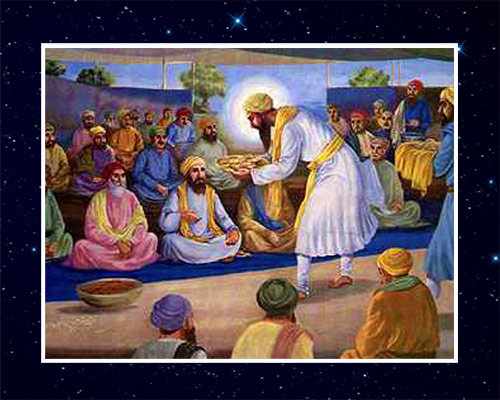 |
|
| Guru Arjan Devji was the fifth sikh guru who lead the sikhs by his sterling example |
And as many had guessed,
once he reached there, he was arrested and imprisoned. Not only that, He
was brutally tortured; but he bore it all with amazing equanimity.
Now Guru Arjan Devji had a
very good friend in a Sufi saint of Lahore, Pir Mian Mir. He was a
great saint of super human powers. On hearing of the arrest of the pious
Sikh Guru, he came to see him in the prison.
Bishu: He was allowed to enter the prison to see Guruji?
Prem: Yes Bishu that is because Pir Main Mir was revered even in the Moghul court. So he had no problem in acquiring permission to meet the Guru. In the prison he saw how Guru Arjan Devji was being put through inhuman torture. He was deeply moved. What also touched him equally strongly was the serenity of Guru Arjan Devji.
Bishu: He was allowed to enter the prison to see Guruji?
Prem: Yes Bishu that is because Pir Main Mir was revered even in the Moghul court. So he had no problem in acquiring permission to meet the Guru. In the prison he saw how Guru Arjan Devji was being put through inhuman torture. He was deeply moved. What also touched him equally strongly was the serenity of Guru Arjan Devji.
Now Pir Mian Mir
definitely wanted to do stop this cruelty. So he offered to intercede
with the emperor on Guruji's behalf. But the Guru refused saying, “Let
the will of God prevail”.
Then Pir Mian Mir
told him, “Why do you endure this torture? If you wish you can destroy
this empire with your powers. If you don’t wish to use your powers, I
will with mine raze to dust this Moghul house.”
Bishu:
He said that? So what was Arjan Devji’s reply? I know he would not have
agreed. But what reasons did he give? You know that was a chance to
teach a fitting lesson to those evil men.
Prem: Yes, I too feel the same. But look at the greatness of Guru Arjan Devji! He
said, “I might have the power to do so, and I even have you, who can do
it for me. But what about the common man whose only weapon is faith and
surrender? I want to counter my pain only with these weapons that
everyone has; I want to set an example for a humble devotee.”
Bishu: What a fantastic soul! Prem... this has stirred some thoughts in my mind.
Prem: What is it Bishu?
 |
 |
 |
 |
 |
 |
 |
 |
| The Golden Temple in Amritsar - the mecca of every sikh. This temple was built in the time of Guru Arjan Dev Ji. It is believed that Pir Mian Mir layed the foundation stone for this holy shrine. | |||||||
Bishu: We always relate the word sacrifice with pain, self-abnegation, endurance and so on.
Prem:
Yes that is true. Even when pain is the obvious result of an act, a
person willingly performs it because it benefits someone else... I think
that’s what sacrifice is all about.
Bishu: Maybe that is the most obvious. But there could be something more to it.
Prem: I don’t get the point you are trying to make Bishu.
 |
 |
 |
 |
 |
 |
 |
 |
Mausoleum of Mian Mir, Sufi Pir of Lahore |
|||||||
Bishu: Take
the examples we have discussed. If pain was the overpowering emotion
how is it that Pir Mian Mir found Guru Arjan Devji in a peaceful state
in the prison? Seeing people with leprosy suffer, Father Damien was
moved to help them. But how is it that when he contracted the same
disease, he still died a satisfied and contented man? Though
it is the pain and deprivation that catches our attention, the joy and
satisfaction, I feel, is far greater than the suffering.
Prem: Yes right. I get it now. That explains Swami’s statement... “Idhi Shrama kaadu bangaru, idhi prema.”
And that also explains the joy of a mother. When a mother prepares a
dish, she always gives the best share of it to her children. And it is
so easy for her to do so. We as children may see it as sacrifice, but
for her, true joy lies in seeing her children enjoy it.
Bishu: How often we have noticed Swami’s face glow with joy when He is giving, be it prasadam, clothes or other gifts or even when He is giving photographs to a group after their performance.
 |
 |
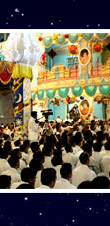 |
 |
 |
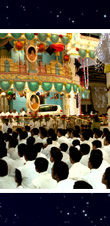 |
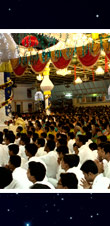 |
 |
| The Sai Kulwant Hall full to the brim during Shivarathri 2011 | |||||||
Elevating Ecstasy Encased in Deep Pain
Prem:
Wow! Doesn't it all fit in place like a huge jigsaw puzzle? The act of
sacrifice or putting your interests behind that of others has hidden in
it bliss far sweeter than that we get by pursuing our needs alone.
Bishu: And this joy, we’ll know only when we give. And when we know it, we shall get addicted to it, if I may say so.
Prem: Yes,
I agree. And speaking about mother, I am reminded of a quote I had read
a long while ago, and as always I don’t remember whose line it is.
Bishu: Okay, what is it?
Prem: It goes: “Is all pain only suffering? Ask a mother who is in labour.”
Bishu: Isn’t that itself a reminder? Really, true joy lies beyond pain. Whenever Swami used to perform the Lingodbhavam, He used to say it is as painful as the process of prasava, or child birth.
Prem: Yes I remember Him saying that many times.
Bishu: But why do you think Swami performed this act?
Prem:
Honestly Bishu, I don’t think I can ever explain this act of His or for
that matter any act of His. I think every aspect of His life is a
lesson He is imparting. It is not necessarily the same lesson for
everyone. Rather I feel each one takes home a lesson that is relevant to
his or her understanding, and spiritual need.
Swami used to say that for those who have witnessed Lingodbhavam,
there is no rebirth. For me, actually that was a repulsive thought.
Because here was my Swami, whom I love so much, obviously suffering, and
why? For me to get liberation? I would tell in my mind, ‘Swami, I don’t
want this liberation, the cost of which is this pain You undergo.’ And I
am sure many of the students and devotees felt the same.
 |
 |
 |
 |
 |
 |
 |
 |
| Different years saw varied manifestations of the linga that emerged from the Lord's being | |||||||
Bishu: Prem, even as you share your feelings about Lingodbhavam, that I can so easily relate to, I am moved by another wonderful thought.
One Act of Pure Love – A Colossus Jump in Consciousness
Prem: What is that?
Bishu: We
were saying that Swami was trying to teach us sacrifice. But in fact, I
think Swami was doing something far greater. A good teacher teaches,
but a great teacher inspires. See, even without our knowledge, He was
inspiring the spirit of sacrifice in us. So much so, we were ready to give up liberation itself! And this He did just through His one act of pure love.
Prem: Amazing Bishu, Amazing!
Bishu: And
now when we look at it, probably that is what Swami did to all His
devotees across the globe, when He chose to remain in the hospital
during those harrowing final days of this earthly sojourn. Well, as you
said, we can never ever understand any of Swami’s acts in its entirety,
but what we do know is that during
that one month or so millions of people around the globe had their minds
fixed on Baba alone and nothing else. Forgetting everything, day and
night they spent only in prayer and service.
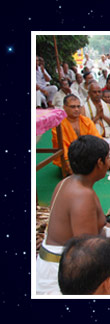 |
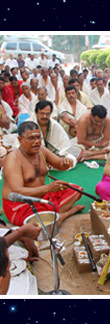 |
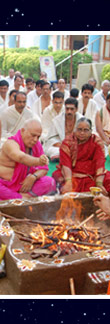 |
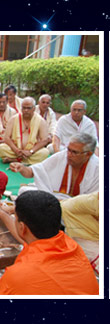 |
 |
 |
 |
 |
 |
 |
 |
 |
 |
 |
 |
 |
| Millions prayed the world over keeping aside their differences and focussing all their energies and love on Swami during that most trying time in April 2011 | |||||||
Prem:
Absolutely. People forgot all their differences, didn’t matter which
community they belonged to or what they believed in, they just came
together and simply poured their heart out in prayer. And you saw poor
feeding, serving in hospitals, helping the handicapped... all these
activities moving into a new gear. During those few weeks everyone was
in some form or the other thinking of Him.
Bishu:
I feel, we all should strive to remain in such a state, in which we
remember Him constantly, if not more at least as much as we all did in
those few days.
Prem:
I can’t agree more with you Bishu. And to remain in that state
cultivating this virtue of sacrifice is so vital. And as we saw when we
sacrifice we receive so much in so many dimensions. We actually are
happier when we give than when we possess.
The “Oneness Way” of Sacrifice
Bishu: So true. Then why is it that many find it difficult to take to this path? What do you think Prem?
Prem:
In fact even I am thinking of the same. My question is: How do these
people sacrifice their joys – these joys which all of us always hanker
after – how do they give these up so easily? How is it that Swami is
able to do this so effortlessly. Agreed He is Divine, but I feel there
must be a way, an approach that will get us to that state. After all
when Swami’s life is His message, we need to follow it, right?
Bishu:
Yes, there indeed is a way. And I think the answer lies in the way
Swami perceived us all. You ask how Swami does so much for others. But
for Swami, there are no ‘others’.
Prem: Hmm, I need to understand this.
 |
|
| Sri Ramakrishna Paramahamsa |
Bishu:
Let me recollect for you a beautiful incident from the life of Sri
Ramakrishna Paramahamsa. You must be aware that he too went through so
much pain towards the last few days of his life.
Prem: Yes, He is said to have suffered from throat cancer.
Bishu: That’s
right. In fact the cancer had proliferated to such an extent that he
would struggle to eat or drink even a little. At that point, his
disciples begged him to pray to the Divine Mother to cure him, at least
relieve him of his pain so that he could take in something.
Though Ramakrishna
Paramahamsa was not inclined to ask the Mother, but seeing the plight of
his disciples he prayed to the Goddess. He
said, “Mother, I cannot eat anything, please give me some relief that I
may eat a little.” And later he recounted to his disciples the Mother’s
response. She gave him a vision of all that there is, and said: 'Why,
you are already eating through so many mouths, why be concerned with
this one!'
Prem: That's something!
Bishu: Yes, now do you understand what I meant when I said, for Swami there is no ‘other’.
Prem: Right. True and complete sacrifice arises only out of the feeling of oneness, when we see ourselves as a part of the whole that God is.
Bishu:
When you have a cut on your finger, and it hurts even to hold a spoon
or a morsel of food, you don’t stop eating, do you? The hand endures the
pain to feed the mouth. But we don’t call it sacrifice. Because the
mouth and the hand are just parts of the same whole.
Prem:
I understand. So when the perception changes, to the way it should be,
when we see and live in that oneness, what appeared to us as sacrifice
will now be entirely different and in fact be a natural way of being.
Neela Kantha Shiva – A Profound Lesson for Humanity
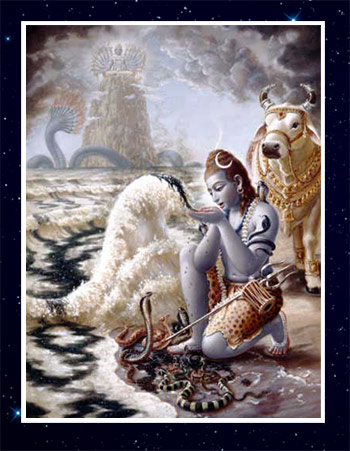 |
|
| The Lord took in the poison of the world spontaneously and came to be revered as Neel Katha Shiva |
Bishu: Yes. Take for instance the mythological episode of Lord Shiva drinking the halahala poison. I am sure you must’ve seen it being depicted in Baba’s presence, and also heard it being narrated by Swami Himself.
Prem: Yes. The demons and the gods churn the ocean of milk with the Mandara mountain and the serpent Vasuki, to obtain amritam, the elixir that grants immortality. And during this churning, many objects come forth.
At one point, the deadly poison, halahala spews out. Then they all run to Lord Shiva for protection, and the kind Lord drinks this venom to protect the creation. Witnessing this, Mother Parvati, His consort, immediately holds his throat so that the poison does not spread further down the body.
At one point, the deadly poison, halahala spews out. Then they all run to Lord Shiva for protection, and the kind Lord drinks this venom to protect the creation. Witnessing this, Mother Parvati, His consort, immediately holds his throat so that the poison does not spread further down the body.
Bishu: And in the process, His throat turns blue with the venom, and hence the appellation, Neelakantha, the One with a blue throat.
Now let us look at this
story in two different ways: What a great example of sacrifice this is!
The Lord drank the poison to save the world.
And the other
perspective is: He who pervades all saw no difference between Himself
and His creation. It was a spontaneous act, similar to how the body
protects that part of itself which is in danger.
Prem:
That is a deep thought indeed. So our endeavour should ever be to feel
that same oneness that the Lord, our Swami feels towards us.
Bishu: That’s right.
Practising Sacrifice – Easy Tips
Prem: Alright Bishu, I agree with all this. But there is still one issue.
Bishu: What is it?
Prem:
When you feel that oneness, sacrifice will be spontaneous. But that is
our problem. We are far from that lofty state. I feel the feeling of
sacrifice and selflessness should be in itself a path to that state. How
can we in daily life leverage these lessons?
Bishu: Well,
each one’s path is unique. Swami is guiding every devotee through a
process that is best suited for that person. So honestly there is no
one-size-fits-all solution. If you wish to know, I can share with you
what I try to do.
Prem: Definitely. I am all ears.
Bishu: A simple way to start with, I feel is, be happy when your neighbour is happy.
Rejoice the success of a friend, does not matter whether he is your
best friend or the opposite; be delighted when the other person is happy
as if it is your own success. When you see someone in pain, empathise
with that person, without being too concerned about whether he is your
own or is a complete stranger. If there is a chance, try and alleviate
the pain to the extent you can. That is how I see it.
Prem:
So it is not just putting someone’s feelings before our own, but
expanding our feelings such that it envelops the joy and pain of the
people around us.
Bishu: Yes, isn’t that an easy way to begin?
Understanding “Na Karmana...” in a New Light
Prem:
It certainly is. Even as I see sacrifice in this new light, I recollect
a commentary I read a while ago and it seems to make more sense now
than ever. It is the famous manthra from the Mahanarayana Upanishad of the Krishna Yajur Veda- “Na karmanaa na prajayaa dhanena tyaagenaike amritatvamaanashuh”
 |
 |
 |
 |
 |
 |
 |
 |
Bishu:
Yes, that was so commonly chanted in Swami’s physical presence in
Puttaparthi. In fact He used to ask for it to be chanted many times. It
means, not by action - karma, or progeny - prajaya or wealth - dhanam can one attain immortality; it can be achieved only through sacrifice - thyaga.
Prem: So profound this verse is! And I think there is an inner meaning there. It says, karma cannot give you liberation, but karma infused with sacrifice will lead you to it. That is, performing action sacrificing the desire for the fruit.
Now what is sacrificing progeny mean? You don’t get liberated by virtue of your lineage or children, but when you have detachment toward all bodily relations.
And finally, it
is not by amassing wealth that one reaches the goal, but when one
readily and spontaneously gives away the wealth acquired in the spirit
of sharing and caring.
Bishu:
Fantastic Prem! What an understanding of this sacred hymn! No wonder
Swami Himself chanted this verse so many times in His discourses and if
we look at His life, Swami just lived up to this message of sacrifice
every second of His earthly sojourn till the very end. In fact I feel
the end was just another chapter in this glorious and eternal Sai Saga
of Pure Love.
Scintillating Signs of Sai Shiva in Sundaram
Prem: So true Bishu. The saga continues so mysteriously and magnificently. Just the other day I heard how a spatika lingam appeared in the Kamandalu when the priest was doing the abhishekam of the Sai Sundareshwar lingam in Swami’s abode in Sundaram, Chennai. In fact Swami Himself had installed this lingam
during the Athi Rudra Maha Yagna held in Chennai in January 2007. And
thousands are thronging to see the shrine in Sundaram where vibhuti is
manifesting non-stop for the last so many weeks!
 |
 |
 |
 |
 |
 |
 |
 |
| The mysteriously manifested Spathika linga in Sundaram, Baba's abode in Chennai | |||||||
Bishu: Yes,
I too heard about this. So awesome are these signs of His presence and
grace! He is as always reaching out to each one of us, ever busy
thinking only about us.
Prem: And now our duty is to think only of Him.
Bishu: Right, that is the reason why we have so many spiritual routines prescribed for us be it bhajans, meditation and so on. The Akhanda Bhajan (non-stop 12 hours continuous bhajan)
during Shivarathri is again another opportunity for us to immerse
ourselves in His thoughts, elevate our feelings and sublimate our
tendencies.
Prem: Exactly so that we may become pure and exude the pure love that Swami exemplifies.
 |
 |
 |
 |
 |
 |
 |
 |
| Every Shivarathri night Sai Kulwant Hall reverberated with soulful bhajans as the Lord graced this occasion with His presence | |||||||
Bishu: Yes Prem, let’s make the most of this Shivarathri. Let it start a new saga of sacrifice in our lives!
Prem: Yes. Wow! What a beautiful discussion we have had! I hope we can do this more often. Thank you so much Bishu.
Bishu: Let’s thank Swami Prem. Sairam till we meet next time.
Prem: Sairam.
TEXTO TOMADO DE: http://media.radiosai.org/journals/vol_10/01FEB12/05_sacrifice_1.htm















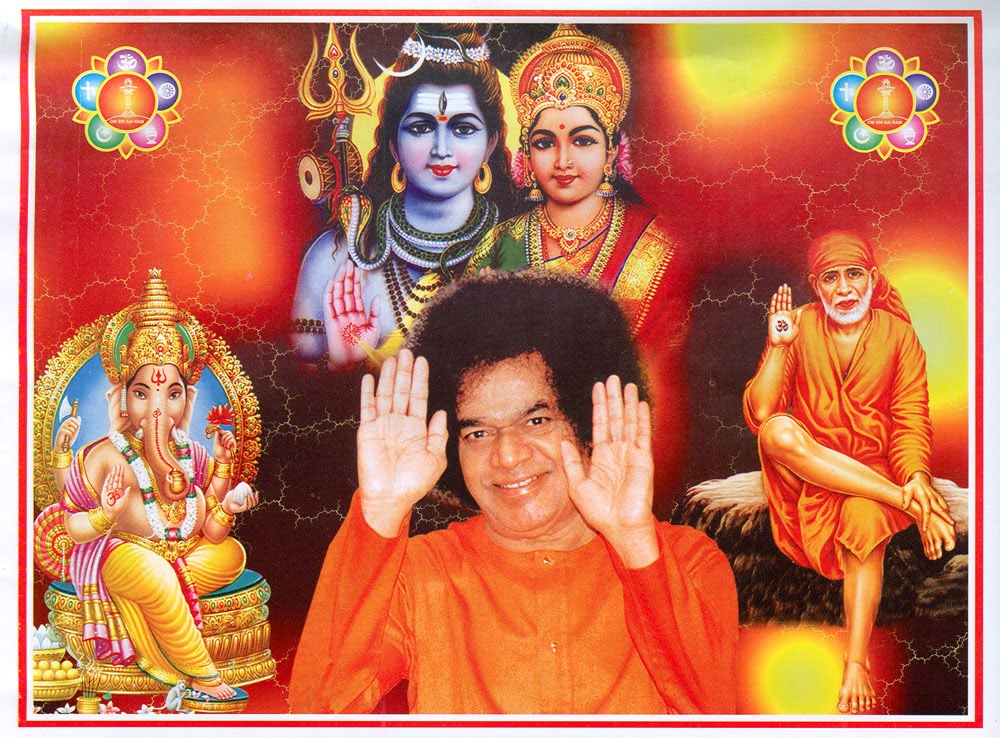







No hay comentarios :
Publicar un comentario